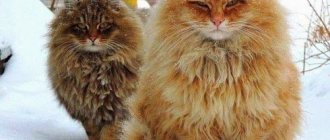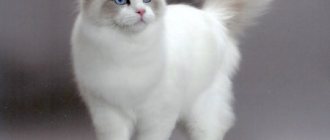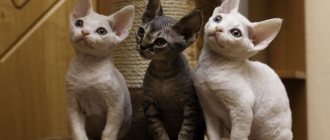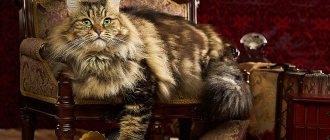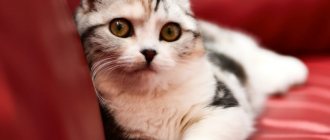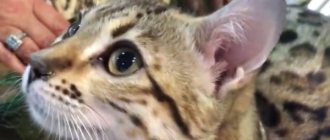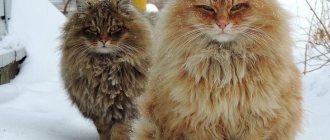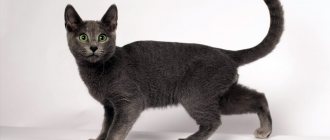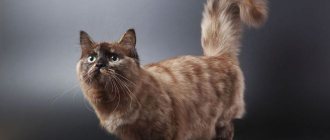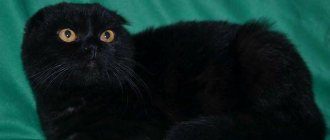Siberian cats are considered real Russian beauties. Their expressive eyes, chic silky “fur coat” and friendly character have long won the hearts of many cat lovers... What other features does this beautiful breed have and how to care for it?
To distinguish this breed from others, you need to pay attention to the following features:
- Body type . Proportional, medium length, but very strong and muscular. The bones are powerful, the tummy is firm, the neck is short, but quite massive.
- Head . Large in size, round and trapezoidal, ears widely spaced and with rounded tips. The eyes are oval and can be green or yellow.
- Tail . Luxurious, unusually fluffy, wide and long, covered with very thick hair, the color of which does not differ from the rest of the coat color.
- Limbs . Quite strong and powerful, not very long, with neat oval legs. Hair grows thickly between the toe pads.
- Wool . Medium length, water-repellent. The color can vary from very light to very dark. Silky to the touch.
This breed, with its average build, is quite large - the weight of adult males can reach 12 kg, smaller females - up to 7 kg. But they only gain weight by the age of five.
History of the breed
There are at least two versions regarding the origin of Siberian cats. There is an opinion that Siberians appeared as a result of mass crossings of some wild taiga cats with domestic cats. According to the second version, the distant ancestors of the Siberian cat came to these lands from the East along with numerous caravans of merchants who were forced to carry fighting cats with them in order to protect their property from hordes of mice and rats.
The Siberian cat has an impressive appearance
The “merchant” offspring remained in Siberia, and then the forces of natural selection came into play - in harsh natural conditions, a special psycho-phenotype of the Siberian cat was gradually formed, a truly unique animal in many of its qualities. Felinologists agree that the origin of the breed can be dated around the end of the sixteenth century.
For a long time these cats were called Bukhara, then for some reason Moscow, and only relatively recently did they receive their current name. They have repeatedly become heroes of Russian folk tales and literary works - for example, the well-known Scientist Cat from Alexander Pushkin is clearly of Siberian origin.
The black Siberian cat is a character in many fairy tales and mystical stories.
People's cat of Russia
One way or another, in large areas of the Urals and Trans-Urals a fairly large population of interesting animals developed, on the basis of which breed selection subsequently took place. From Siberia, charismatic cats began their victorious march across the Eurasian continent, and then across others.
Thanks to the consistent actions of enthusiasts and systematic breeding work, the Siberian cat has received well-deserved recognition throughout the world. At the end of the eighties of the last century, Moscow, Leningrad and Riga nurseries made a great contribution to the formation of the breed. In the Kotofey club in 1987, its first standard was created, which has since undergone some changes, and five years later the World Organization of Cat Fanciers included the breed in its official lists.
Siberian cats are well adapted to harsh climates
The popularity of Siberian cats among the people was incredibly high, especially given the recent shortage of all other cat breeds. Luxurious fluffy beauties walked proudly through courtyards and streets, delighted their owners, caught mice, gave birth to kittens “out of love,” and no one really thought about such concepts as the gene pool and purity of the breed. Although, perhaps, such democracy has benefited her - fresh blood is still pouring into the breed.
Interestingly, the breed remains open to this day. Any foundling phenotypically similar to a Siberian can receive a certificate of belonging to the breed - a registered pedigree - if it is awarded a club referral to an exhibition and earns at least two “excellent” ratings there. There are very real stories of cats picked up in a trash heap who became titled producers, and a cat of the same street origin named Mars even received the title of World Champion.
Métis
A well-known mixed breed is the Neva Masquerade - a Siberian with the coloring of a Siamese. This is a beautiful animal with thick fur. These cats are loved for their original appearance and serious character.
There is also a cross between a Siberian and a fold breed. The pets are original in that the type has drooping ears and facial features of a Scottish cat, and the fur comes from a Siberian cat.
There are also Persian mestizos. Due to the fact that Siberian cats are similar to Persians with a thick collar and panties, these breeds are not related. Often, unscrupulous breeders cross the popular Persian breed with the Siberian breed to produce mass offspring similar to Siberians.
Siberian cat - description and standard
Siberians are a source of pride for Russian felinology. They are rightfully considered an indigenous breed of Russia and deserve to be recognized as its national treasure. The modern breed standard describes in detail not only all the main characteristics of a cat, but also its shortcomings, which is extremely important for responsible breeding work.
The Siberian cat is pure perfection and dignity
Appearance
The standard of the Siberian cat has cemented the brutal image of a strong and beautiful animal, which harmoniously combines the features of the legendary forest animal and the affectionate domestic purr. Heavy type, powerful bones, stocky, strong, rectangular body harmoniously combines with a large head and a wide, long, very fluffy tail.
Males of Siberians can be significantly larger than females. A massive, tightly built cat should weigh between five and ten kilograms, while a smaller cat should weigh between four and six kilograms. Moreover, animals with a weight in the upper limit are extremely rare. The stories about thirty-kilogram Siberians are, to put it mildly, untrue, tales for impressionable buyers.
The Siberian cat is usually much larger than a cat
The special pride of the Siberian cat is, of course, its fur . Shiny, long and thick, with hard topcoat, it should have a sufficient amount of soft undercoat. Siberians fully “dress” only towards the end of autumn, when they appear in all their glory before the admiring glances of their fans. In the warm season, cats “wear” a lightweight, but still very beautiful version of the fur coat.
A beautiful fur coat is the pride of a Siberian cat
It is difficult to even imagine another breed that, like the Siberian, would be rich in colors - the standard does not limit creative breeders in this at all, and the results of their creativity are absolutely amazing. The Siberian breed standard does not allow only three colors:
- point;
- Abyssinian;
- lilac.
Photo gallery: Siberian cat color palette
The tortoiseshell golden spotted color is highly valued among Siberian cats.
The “blue spotted with white” color pleases the eye with a chic light collar
The color “cream and white” has delicate shades of pastel undertones
The color “black” is the most mystical and mysterious
The “black smoke” color is especially beautiful when the animal is moving.
The color “bicolor white and blue” is simple, but so cute
The color “bicolor white and red” is very bright and elegant
The “black tortoiseshell” color is typical only for cats, in very rare cases - for sterile cats
The color “red marble” is popularly called red
The “blue” color turns even the cat’s nose a soft gray color.
The color “black marbled” is a very impressive traditional color of Siberians
The color “black brindle” is expressed in alternating black and light stripes
Video: Siberian cats in the village
Character and behavior
Siberian cats are full of dignity, they know their worth and will not tolerate familiarity. At the same time, they are unobtrusive and friendly, get along easily with small children, and are tolerant of other pets - but only if they unquestioningly recognize their leadership status.
By nature, these are typical sanguine people, but in a critical situation they can stand up for themselves to the fullest. Legends can be made about the fearlessness of Siberian cats - the animal does not forgive insults and will definitely defend its violated dignity. The offender will be punished, and his size does not matter at all - an angry Siberian is capable of putting a large dog, and even a person, to flight.
Despite their impressive size and rather menacing appearance, Siberians are distinguished by a calm, non-conflict disposition and can be very affectionate. The owner means a lot to representatives of this breed - they want to respect, understand him and constantly be near him. The cat constantly follows the person around the house, abandoning even its most urgent tasks for the sake of this. Their loyalty and devotion is amazing and touching.
It's better not to awaken the beast in this cute animal
Siberians have not lost the hunting instinct that is reliably laid down by nature and continue to catch mice very well, and in their absence they will not deny themselves the pleasure of hunting birds and other small game that comes into their field of vision. Some owners also talk about the watchdog qualities of their pets - indeed, there are Siberian cats that guard the territory entrusted to them no worse than dogs.
Video: Siberian cat - what the owner needs to know about the breed
Peculiarities
You should familiarize yourself not only with the character of the Siberian cat, but also with the breed standards. Features include the fact that it is a large, muscular animal with a powerful torso. His body is heavy, his neck is short, and his lamps are compact. Between the paws there are long tufts of hair.
Cats have a small head, the cheekbones are low, and the forehead is slightly pushed forward. The animal's nose is smooth and wide. The eyes are oval-shaped, slightly slanted. The ears are medium in size and slightly tilted forward. Cats have a wide and bushy tail that hangs evenly down.
These cats have a magnificent fur coat. Since they live in Siberia, they have acquired characteristic features. Long hair is the pride of the breed. Thanks to their thick undercoat, the animals are fluffy and can withstand severe frosts. The cat captivates with its natural beauty and grace.
Buying a kitten
Choosing a kitten is a responsible step, because you are purchasing not just an animal, but a new family member who will become your faithful friend for the next two decades.
A Siberian pet will definitely become a member of your family, so you should take its choice seriously
Some tips:
- Prepare theoretically in advance: try to learn as much as possible about the characteristics of the Siberian breed and the rules for its maintenance.
- “Try on” the cat to your home conditions: think about where he will eat, sleep, go to the toilet, and play.
- Be sure to come to a consensus with all your family on the issue of purchasing a cat - the animal will feel comfortable if it does not bother anyone.
- In a timely manner, select everything necessary for the kitten: bowls for food and water, a tray, a scratching post, combs and toys, stock up on food.
And of course, the most important thing is to decide what kind of kitten, where and why you want to buy. As has already been said, there is nothing wrong with even bringing a cat into your home from the street, much less buying it at a bird market or borrowing it from friends. There are a lot of options - but none of them guarantee that a miracle will happen and thus a truly purebred animal will appear in your home. There is little chance that it will be at least healthy and with a stable nervous system.
A kitten from the street or from friends may differ from the breed standards, even if it looks very similar to a Siberian
How to choose
If you want guarantees, choose a reliable breeder first, and only then a kitten. The choice of nurseries that breed the Siberian breed today is quite large, and they all value their reputation. They will help you choose a child based on his expected prospects and your ambitions.
Remember that a show-class animal can cost several times more than just a pet, which will delight you no less. But if you plan to participate in exhibitions and breeding, then it is better to purchase an older kitten - its qualities can be assessed more accurately. In all other cases, you need to choose a baby no younger than two and a half months - by this age he must be vaccinated and accustomed to at least the basic rules of independent living in a new home.
Do not buy a kitten that is too small - let him grow up a little next to his mother, who will teach the basic rules of cat behavior in the house
If possible, talk to the baby's parents - their appearance and behavior can outline the characteristics of the pet you choose. Listen to the breeder's recommendations - this will help you properly raise a healthy and beautiful animal.
Lifespan
Life expectancy depends on various factors. This is influenced by heredity. Since the ancestor of Siberians was the Bukhara breed, the animals will have strong immunity. Pets are also hardy and resistant to diseases. On average, a cat lives 15-17 years, but sometimes there are long-livers - more than 20 years.
It is necessary to contact a veterinarian in a timely manner and not self-medicate. It is also important to monitor his behavior. If an active animal suddenly does not want to play or eat, you should contact a veterinary clinic.
Keeping a pet
Large and heavy Siberian cats belong to breeds of late maturation and finally complete it only at the age of five, when both males and females acquire mature forms - they mature and acquire muscle mass. Although by the age of three the animal is considered to be fully developed physically - which, however, is also not too early.
Only by the age of five will your cat fully mature and acquire the full appearance of the Siberian breed
These important factors must be taken into account when keeping animals of this breed, thinking over their diet and regulating physical activity.
Feeding
Breeding nurseries recommend high-quality ready-made food as the basis for the nutrition of Siberian cats - this way, a balanced menu is guaranteed. This is important, if only for the reason that Siberian women are prone to overeating, and too high-calorie food in combination with physical inactivity can provoke diseases of the digestive system and cardiovascular system.
But many owners still prefer to feed their pets natural food, especially since representatives of this breed love to eat not only a lot, but also delicious food. It is necessary to remember that Siberian cats, as well as all other cats, are strictly contraindicated from eating food from the master’s table. Their usual diet should consist of three-quarters of animal protein: raw meat, poultry and fish (preferably boiled). As an addition to the main menu, you can give fermented milk products, quail eggs (1-2 pieces per week), a small amount of cereals and vegetables.
Keep in mind that your Siberian pet needs its own diet
Sweets, legumes, pasta, potatoes, and baked goods should not be given to cats, as well as fatty, spicy, fried, and pickled foods. Do not experiment with the health of your pet - feed it correctly, twice a day, and in no case overfeed it. A three-month-old kitten should eat five times a day; as it grows, the number of feedings decreases, and single portions increase.
Hygiene and grooming
The abundance and thickness of the coat determine the need for careful care, which, however, is much simpler than that of the Persian breed. The beautiful coat of a Siberian cat should be combed from root to tip at least twice a week, paying special attention to areas with soft hair where there is a high risk of tangles. During the shedding period, brushing with a furminator should be made a daily procedure - otherwise all surfaces in your home and your clothes will be covered with a layer of cat fluff.
It is necessary to comb your Siberian twice a week or more often.
It is not recommended to resort to such radical methods as cutting and shaving, even if your cat does not participate in exhibitions. Drastic grooming will inevitably ruin the structure of the coat, and it will be extremely difficult to restore it.
With the correct structure, the fur of a Siberian cat has the property of self-cleaning, so there is no need to bathe the animal too often - only when it gets dirty. Any shampoo for long-haired cats is suitable for bathing. It is better not to leave the wool wet; you need to dry it with a hairdryer while combing it with a slicker. The Siberian breed is not afraid of the cold, but does not tolerate drafts at all.
If you don't comb your cat, you'll have to cut it.
Like any cat, regular care of the ears, eyes and claws is important for the Siberian. In order to prevent inflammatory diseases, the ears must be wiped weekly with special products or at least a small amount of boiled vegetable oil. Just don’t get carried away with this and don’t try to clean the ear canal too deeply - this can only cause harm. It is enough to wipe the eyes from time to time with a damp cotton swab.
The claws of Siberian cats are usually not trimmed - they renew themselves quite well. But it won’t hurt to accustom your animal to a good scratching post in a timely manner.
Physical exercise
The well-developed muscles of the Siberian cat must be constantly maintained in proper shape. Despite some external clumsiness, these animals are very mobile and, if they have the opportunity to walk in nature, they provide themselves with the necessary physical activity: they happily climb trees and roofs, and on occasion they will not refuse to swim or take part in a “safari” of anything that moves.
A cat that walks by itself will always be in good physical shape.
When kept indoors, the cat's dynamics, unfortunately, are limited to games - by the way, Siberians prefer balls to all other toys and can even learn to fetch them. But play “physical education” is not enough for normal muscle condition, so if you care about your cat’s health, provide her with regular exercise. This will also benefit your home, where the amount of destruction will immediately noticeably decrease.
You need to start training your kitten early to walk on a harness.
Be sure to walk your cat on a harness and leash. Free walking is not for a Siberian - she will almost certainly spot an enemy, victim or prey on the street and set off in pursuit, and then you will have to catch or even look for your pet for a very long time.
Video: caring for the “Siberian”
Hygiene
Cats that do not leave the house should be bathed no more than once a year. An animal that is taken for a walk should be bathed once a quarter. Cotton swabs are placed in the ears to prevent water from entering. Place a non-slip mat or towel on the bottom of the container. Shampoo-conditioners that are used for long-haired cats are used for washing. After bathing, dry the wool with a towel or hair dryer.
The pet's eyes should be wiped with cotton swabs or a clean napkin when discharge occurs. The ears are examined regularly. If you need to clean from wax and dirt, you need cotton swabs moistened with a special lotion. To cleanse teeth and mouth from plaque, toothpastes are used. It is periodically required to use preventative treats. Almost no nail trimming is required, so a standard scratching post is needed. Thanks to high-quality hygiene, the animal will always be happy.
Breed defects
Despite its long history, the Siberian cat breed has not yet been fully formed. Sometimes genes can develop in such a way that the offspring will have problems with both phenotype and health. If in the first case the defects are regarded as a breed defect and do not at all interfere with the normal life of the cat, then hereditary diseases should be a signal to the breeder that it is advisable not to allow this line of sires into breeding.
Major diseases
The peculiarities of the formation of the breed generally had a positive effect on the health of its representatives. Having gone through a long stage of natural selection in the harsh climatic conditions of Siberia, these cats have learned to perfectly resist many diseases. The famous Siberian health is fully inherent in them, which is one of the undoubted advantages of this breed. If well maintained, a Siberian can live twenty years or even more.
Typically, Siberian cats have good health, but pathologies are possible
Among the hereditary diseases to which these animals are predisposed is hypertrophic cardiomyopathy, a severe but fortunately rare heart disease that usually ends in death.
Siberian cats by nature are textured, powerful animals; A strong, well-formed bone structure is especially important for them. Improper cultivation, regular overeating and lack of sufficient exercise can lead to the development of musculoskeletal problems. Like all heavy individuals, Siberians have risks of dysplasia and other joint diseases, especially in old age.
In recent years, such illnesses have been provoked by unscrupulous breeding work. Some, by hook or by crook, try to get overly large animals that look impressive and are expensive. Unfortunately, few people realize that high-quality cultivation of such giants is not only very difficult and expensive, but is also fraught with many health problems.
Pedigree marriage and disadvantages
A disadvantage of the breed is considered to be a straight profile - ideally, the transition on the muzzle from forehead to nose should be very smooth. The massive rounded head of the Siberian cat is generally the subject of close and meticulous attention of experts who, acting in accordance with the standard, can find a number of disadvantages here:
- too short or, conversely, long lightweight muzzle;
- flat cheeks;
- high cheekbones;
- weak chin;
- small, round or deep-set eyes;
- large or small, incorrectly set or too furry ears.
Breed defects are “written” on the cat’s face
Also a serious drawback can be considered a square or overly stretched body format, its lightness and grace. Elegance and grace - this is definitely not what is said about the Siberian. He walks, leaning heavily on his strong paws, which should not be thin or high. Special requirements apply to the tail: the more luxurious it is, the better. A bald or short, expressionless tail is a definite breed defect and a personal disgrace for a Siberian cat.
Health
Animals have good health and excellent endurance, but are predisposed to obesity. Sometimes it happens that since a pet refuses food from the table, it is overfed or given highly fatty food. This cannot be done to preserve the health of your pet.
A cat's teeth change at 3-4 months. During this period, irritation occurs on the gums and stomatitis may appear. When walking, a cat can pick up parasites, so it needs to be treated regularly. With the help of prevention and vaccination, many problems can be avoided.
Breeding work
The global popularity of the Siberian cat is growing, and breeding nurseries, engaged in breeding, are moving towards improving the breed. The so-called traditional colors and the Neva masquerade cat (Siberian colorpoint) have recently become the most popular - many breeders specialize in these varieties of Siberians.
Neva Masquerade - the fruit of love between Siberian and Siamese cats
The Neva Masquerade cat is a young independent breed created on the basis of the Siberian cat; it combines all six varieties of point colors, which are unacceptable according to the Siberian breed standard. Initially, these blue-eyed fluffy cats appeared as a result of the hybridization of Siberian and Siamese breeds, but in many respects they are still classified as Siberians.
Breeding Features
Siberian cats are endowed with very strong genetics and an amazing ability to reproduce. They are prolific - one litter can have from five to ten kittens, which almost never happens in other breeds. Male Siberians do not lose their reproductive qualities until they are eleven or twelve years old, and females do not lose their reproductive qualities until they are eighteen years old. Of course, at this age, owners should not allow offspring to appear - this is too difficult for an elderly animal.
Siberian cats retain reproductive abilities into old age
The selection of healthy sires with good heredity plays a primary role in breeding work. In addition, for breeding Siberian cats it is very important to navigate the genetics of colors, which are so richly represented in this breed.
Table: possible colors of Siberian kittens in the litter
| Cat | Cat | Kittens-cats | Kitten cats |
| Black | Black | Black Blue | Black Blue |
| Blue | Black Blue | Black Blue | |
| Red | Red Cream | Tortoiseshell Blue-cream | |
| Tortoiseshell Blue-cream | Cream | Red Cream | |
| Tortoiseshell | Black Blue Red Cream | Black Blue Tortoise Blue-cream | |
| Blue-cream | Black Blue Red Cream | Black Blue Tortoise Blue-cream | |
| Blue | Black | Black Blue | Black Blue |
| Blue | Blue | Blue | |
| Red | Red Cream | Tortoiseshell Blue-cream | |
| Cream | Cream | Blue-cream | |
| Tortoiseshell | Black Blue Red Cream | Black Blue Tortoise Blue-cream | |
| Blue-cream | Blue Cream | Blue Blue-cream | |
| Red | Black | Black Blue | Tortoiseshell Blue-cream |
| Blue | Black Blue | Tortoiseshell Blue-cream | |
| Red | Red cream | Red Cream | |
| Cream | Red cream | Red Cream | |
| Tortoiseshell | Black Blue Red Cream | Red Cream Tortoise Blue Cream | |
| Blue-cream | Black Blue Red Cream | Red Cream Tortoise Blue Cream | |
| Cream | Black | Black Blue | Tortoiseshell Blue-cream |
| Blue | Blue | Blue-cream | |
| Red | Red cream | Red Cream | |
| Cream | Cream | Cream | |
| Tortoiseshell | Black Blue Red Cream | Red Cream Tortoise Blue Cream | |
| Blue-cream | Blue Cream | Cream Blue-cream |
The genetics of colors are not random accidents
In what cases is sterilization necessary?
The main argument for sterilizing an animal can only be medical indications when it comes to its health or even life. Also, sterilization or castration may become a condition of the breeder when selling a kitten, which he does not consider possible to allow for breeding. It is also impossible to obtain offspring from overly aggressive animals - in such cases, sterilization usually reduces the level of hostility.
All other situations must be carefully analyzed to determine the advisability of the operation - surgery is performed under general anesthesia and can be fraught with serious complications.
Character
What are the habits and character of the Siberian cat? He is a leader by nature, so he does not recognize other animals in the house. The pet will be loyal and will single out one person in the family as its owner. According to reviews from owners, the character of the Siberian cat is good-natured, loyal and tactful. He is inquisitive, prefers to attract attention and demand communication. By nature, black Siberian cats are hunters. Therefore, when living in an apartment, they should have toys and various entertainment.
Judging by the available photos and character, the Siberian cat loves to play. Papers, balls and other rustling objects can be used for this. Characteristic features of the Siberian cat breed include their love of water. They can sit in the bathtub and throw or catch toys.
The character of the Siberian blue cat includes their lively mind and quick memorization of their nickname. If you also get a dog, this will not scare the Siberian. But the other cats will be rivals. These animals love to watch people, especially when at altitude. According to reviews, the character of Siberian cats is responsive. They become attached to a person and become true friends. Cats sense people's attitudes.
Table: pros and cons of the Siberian breed
| Breed Features | pros | Minuses |
| Character | Calm and balanced | Sometimes vindictive, vindictive and aggressive |
| Content | Easy to maintain and care | Requires regular brushing and walking |
| Nutrition | Can eat both ready-made food and natural food | Tends to overeat and is picky about food |
| Health | High resistance to diseases | Predisposition to joint pathologies |
Feeding
The pet prefers a variety of food, so feeding it will not be difficult. It is important that your diet contains the necessary proteins and vitamins. It is especially important to control the feeding of kittens up to 3 months. Food should be of high quality and served 6 times a day.
Food must be purchased from trusted sources. The diet should include dry food and canned food, natural food. The cat should eat lean meats - beef, chicken, rabbit, turkey. You also need fish, seafood, eggs, kefir, cottage cheese.
The animal must be fed in sufficient quantity. It is important that it does not overeat and does not consume fatty, sweet, spicy foods. Various vegetables are suitable - zucchini, carrots, potatoes. They can be served separately or added to meat or porridge. There must be a container with drinking water.
Kitten care
While caring for a kitten, he is taught cleanliness skills. The pet takes care of its appearance, tidying itself up after each meal. But this is not enough. The following procedures must be carried out:
- Comb your hair using a special comb. It is advisable to do this as often as possible so that the animal gets pleasure from combing its fur over time.
- Swim as needed: after the dacha, walks outside, when the fur and paws become dirty. If the kitten lives only in an apartment, then bathing is a rare and optional procedure.
- Make sure that the kitten does not have fleas. It is necessary not to get rid of fleas, but to prevent their appearance. To do this, they dab the kitten’s withers with Frontline and Advantage and calmly let it go for walks around the dacha area.
- Clean your ears. To do this, lay the furry pet on your lap, carefully turn away the ear and clean out dirt or other unnecessary accumulations using a turunta or a cotton swab. The cat should not have any negative feelings left after this manipulation.
In addition, you should get the necessary vaccinations by contacting your veterinarian. In two weeks, treat the baby for worms using the drug Drontal. Its use is one-time only and guarantees elimination of parasites.
The growth of a Siberian kitten continues up to 2 years. At 2-4 months, he turns into an “ugly duckling”: his legs begin to stretch out, his body becomes disproportionate. But this is a temporary teenage phenomenon. Gradually the pet will gain strength and turn into a luxurious “Siberian”.
One of the important points is toilet training the kitten. The tray should be installed in a remote, convenient location. You need to remove the grid from the tray and put in the torn paper. It is advisable to temporarily limit the baby’s movements to the area of the apartment where the home toilet is located.
If the kitten leaves puddles on the floor, wipe them with vinegar. Some owners teach their Siberian kitten to use the sink or bathtub. In rural conditions, problems with the toilet rarely arise: a hole in the cellar or a trip to the street is enough.
From Moscow to Russian national: prerequisites for the formation of breed standards
Whatever wild ancestors the cats from the Siberian regions originated from, initially for the formation of a standardized breed, which began in 1986 in Moscow and St. Petersburg, their genes were not a priority. The fact is that breeders selected mainly the largest and fluffiest domestic cats of this type for breeding. It was much simpler than sending expeditions to remote villages in search of an ideal. That is why in those days the Siberian breed almost turned into the Moscow one.
pixabay.com/giomione
Russian national that conquered the world
The work of the breeders was not in vain, and over time the Siberian cat, which without any guile can be called the Russian national cat, gained popularity all over the world. For the first time, Siberians publicly demonstrated their excellence in 1987 at a specialized exhibition event in the Moscow region. The official breed standard, determined by the SIB code, was approved only in 1990. Then active breeding of the Russian Siberian cat continued in the USA. In 1991, the new breed standard, developed by Russian Olga Mironova , was registered with the World Cat Federation (WCF), and four years later, Russian felinologists conquered another prestigious cat federation - FIFe. Thus, for the first time in history, the breeding work of breeders from Russia received recognition at the international level. And all thanks to the fluffies who came to us from the Siberian expanses.
